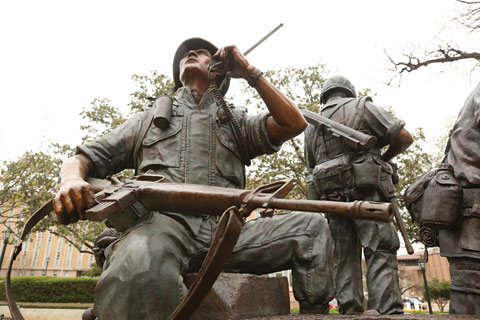 |
||||||||||||
|
July/August 2014 Mission Accomplished:
BY MARY BRUZZESE VVA has been connected to the Texas Capitol Vietnam Veterans Monument (TCVVM) from its inception. The monument was dedicated March 29 on the northeast side of the Texas Capitol grounds in Austin. It is a tribute to all Texans who served during the Vietnam War and honors the 3,417 Texans who died or are unaccounted for. More than 4,500 people—including VVA President John Rowan and many other VVA members—attended the dedication, a record crowd for an event held at the capitol. TCVVM Committee and Austin, Texas, Chapter 915 member Terry B. Burkett addressed all Texas Vietnam veterans: “This monument is a testament to your honor, your courage, your sacrifice, and that of your families. Today marks the end of a long mission.” He then introduced those chosen to unveil the monument—including Texas State Council Vice President and Beaumont, Texas, Chapter 292 President Kerwin Stone. TCVVM Committee Chair and Chapter 915 member Robert Floyd talked about the indifference Vietnam veterans faced when returning home. “Now Vietnam veterans are hopeful,” he said. “Hopeful that the millions of people who visit these grounds will pause here to learn. Hopeful that the families whose loss can never be measured will come here to remember.” Three wreaths were presented, one on behalf of Gold Star and MIA families, one on behalf of Texans of Vietnamese heritage, and one on behalf of the people of Texas. The monument was blessed as a place of healing by Native American veterans of the Lone Star Hethuska Society. “I was so proud being at the dedication with so many Vietnam veterans,” Stone said. “If you can envision 4,500 engaged in a group hug, that was the overall feeling at the ceremony.”
In 2005 the 79th Texas legislature unanimously approved the placement of the monument. The legislation was co-sponsored by Sen. Hinojosa and Rep. Smith and signed by Gov. Rick Perry on May 20, 2005. The TCVVM Committee, made up entirely of Vietnam veterans—including Chapter 915 members Floyd, Burkett, Don Dorsey, John Miterko, and Kerry Orr—formed in 2008. “From the beginning, a big part of our focus was on those 3,417 Texans who were killed in Vietnam,” Floyd said. “Everyone on the committee knew someone or had a connection to someone who lost a member of their family in Vietnam.” Dorsey, Burkett, and Miterko began to spread the word about the monument. Dorsey, a veterans activist since the 1970s, had many connections in the veterans community. Burkett drove around the state to talk about the memorial. He made presentations at several Texas State Council meetings and at the meetings of a few Texas chapters. The state council, in turn, spread the word to its chapters. An email list also was set up to update VVA members. The TCVVM Committee chose Duke Sundt as the monument’s artist. The creation of the monument took about a year and was completed at the Deep in the Heart Art Foundry in Bastrop. More than six hundred individuals, public officials, corporations, foundations, and organizations donated to the monument, with donations ranging from $5 to $500,000. The Texas State Council donated, as did several chapters. “Texas is a big state,” TCVVM Committee Coordinator Cheryl Fries said, “and some of our VVA chapters are very rural and have little resources. Their smaller donations were just as appreciated as the large-dollar ones.” Chapter 915 donated thousands—money raised through a poker tournament and raffles. Chapter 292 and the city of Beaumont co-sponsored a Welcome Home Brother Weekend in September 2012 to raise money for the monument. The proceeds from auctions held over the weekend, along with the sale of military memorabilia, totaled $70,000. The Texas Historical Commission had agreed to match whatever was raised, so the total donation was $140,000.
The bronze monument, standing fourteen feet at the highest point, depicts a five-man infantry patrol atop an octagonal base decorated with eight bas reliefs. Benches featuring the POW/MIA symbols surround the monument. The five figures represent a medic or Navy corpsman attending to a wounded serviceman, a grunt, a sniper, and a radioman. The men sit atop the ruins of an ancient temple, waiting for a helicopter. The Combat Patrol figures represent the ethnic diversity of the Texans who fought in the Vietnam War: Caucasian, Hispanic, African American, Native American, and Asian American. The base’s front panel depicts the Texas state seal between two fighting dragons, representing North and South Vietnam. The other panels depict various aspects of the war such as air power, the Brown Water Navy, the Blue Water Navy, field artillery, the infantry, scout dogs, dustoffs, nurses, and donut dollies. Entombed beneath the base are dog tags for each of the 3,417 Texans who died or are MIA from the Vietnam War. The tags were hand stamped by Don Dorsey in a Vietnam-era machine, a process that took several months and more than four hundred hours. The tags are encased in a Vietnam-era ammo can fitted with an engraved plaque. “When you joined the military,” Dorsey said, “you were stripped of your identity and made a number. So I wanted to give them back their identities of being hometown kids.” Two copies of each dog tag were created, one entombed beneath the monument, the other displayed in the Texas Heroes Exhibit. This exhibit, which is touring the state, displays the dog tags arranged in alphabetical order. The day before the March 2013 groundbreaking ceremony, all 3,417 names were read aloud at the Lyndon B. Johnson Presidential Library in Austin. The Heroes Exhibit made its debut at the LBJ Library the same day.
When visiting the monument, Floyd said, “Look into the eyes of these five young men. Try to understand the feelings that they were having, these five guys in the middle of a country at war. Touch them. Think about them. Think about their families. Walk around the panels. They tell the story of the war. These people really did exist, and they really did make a contribution to this country. “This monument is a welcome home that we never received when we came back from Vietnam. This monument says to us, ‘We welcome you back, we are proud of you, and you will not be forgotten.’”
|
||||||||||||
|
|
||||||||||||
|
||||||||||||
8719 Colesville Road, Suite 100, Silver Spring. MD 20910 | www.vva.org | contact us |
||||||||||||









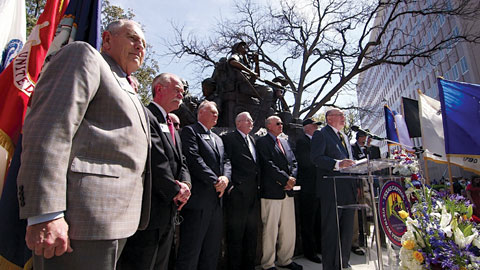
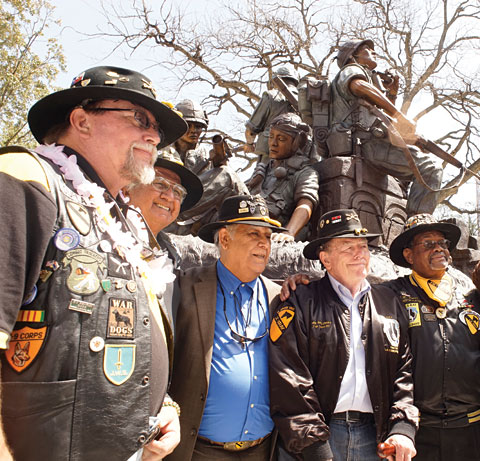 In late spring of 2003 Robert Floyd was walking past the Korean War Memorial on the Texas Capitol grounds when he realized that there was a monument for every war Texans have fought in since the Alamo—except Vietnam. Floyd contacted fellow Vietnam veteran Rep. Wayne Smith. Together they approached Sen. Juan “Chuy” Hinojosa, also a Vietnam veteran.
In late spring of 2003 Robert Floyd was walking past the Korean War Memorial on the Texas Capitol grounds when he realized that there was a monument for every war Texans have fought in since the Alamo—except Vietnam. Floyd contacted fellow Vietnam veteran Rep. Wayne Smith. Together they approached Sen. Juan “Chuy” Hinojosa, also a Vietnam veteran. 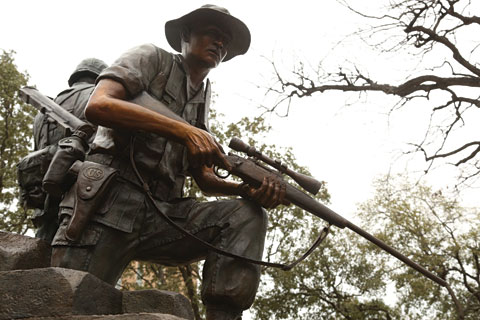
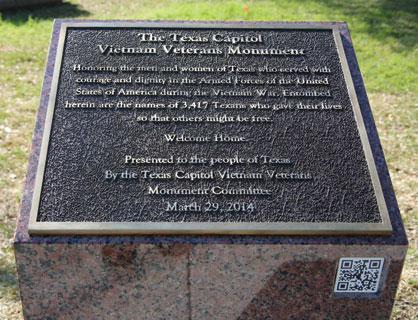 The TCVVM is media savvy. Visitors with mobile devices can scan the QR code on the monument plaque to get a mobile tour explaining the symbolism of the monument. This virtual tour can also be taken on the monument’s website,
The TCVVM is media savvy. Visitors with mobile devices can scan the QR code on the monument plaque to get a mobile tour explaining the symbolism of the monument. This virtual tour can also be taken on the monument’s website, 